Pros

- Channel Bonding: Speedify allows the user to connect to the VPN network through more than one means like cellular data, Ethernet, Wi-Fi, etc. The client then uses all these connections simultaneously to provide the best VPN experience to the user. We have discussed this feature in detail in the later sections.
- DNS leak protection: They claim to have DNS leak protection. It is always good to have as many security measures as one can to protect his/her privacy online.
- P2P servers: There are dedicated P2P servers on the network, and the service also supports BitTorrent on these selected servers.
- NAT firewall: Technically it is not a firewall, and they also don’t claim it to be a firewall. But it is an added security feature, and as we said earlier, it is always better to have as many security measures as one can.
Cons
- US-based: The company is based in Philadelphia, USA. We all know that the US government is a nosy one, and it is a bad omen to see the mention of USA in the VPN world.
- Encryption: In this day and age, when 256-bit encryption has become a norm for VPN services, Speedify can’t lure users with 128-bit encryption. VPNs are all about security, and they should also try to buff up their product with security measures.
- Platforms: The service is available only on Windows, MacOS, Android, and iOS devices. With so many platforms available to the users for using the internet, Speedify needs to come up with a service that protects the users on these other platforms as well.
- No Netflix: This might matter a lot to the binge-watchers out there. Netflix has blocked Speedify servers, and the user cannot stream content on Netflix using this service.
Oveview
Speedify comes from a US-based company called Connectify. Inc. The USA is one of the 5-Eyes countries, and it has also got NSA which has somewhat a bad reputation of spying on its own citizens.
| Quick Overview | |
|---|---|
| Protocols | Channel Bonding |
| Platforms | Windows, Mac, iOS, Android |
| Jurisdiction | USA |
| Logging | No Log |
| Encryption | ChaCha- or AES-based |
| Connections | Up To 5 Devices |
| Locations | 50 + Locations |
| Servers | 200+ |
| Netflix/P2P | P2P Available |
| Payment Options | Debit Card, Credit Card |
| Support Options | Email Support |
| Pricing From | $ 4.17/mo Billed for 12b months |
| Guarantee | 30 Day |
| Free Trial | Yes |
| Website | Visit Website |
It appears more like a product directed towards mobile VPN services, but they claim to be equally suitable for desktops and other devices.
Apart from the ‘Channel bonding’ feature, they don’t seem to bring much to the table.
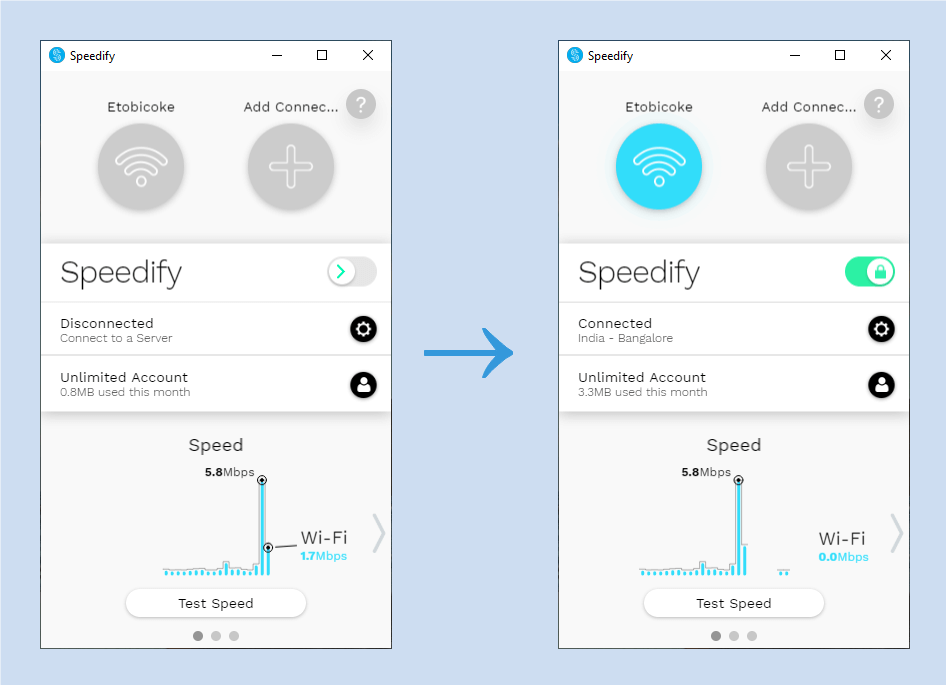
The country of jurisdiction is anyway sort of a security threat, and along with that, they lack 256-bit encryption and multiple protocols.
However, they claim to be among the fastest VPN services, and the client also appears to be user-friendly.
They have got a good number of servers across various locations and claim of a no-logging policy.
In this review, we will examine if the service is actually good for desktops and test their claims. Most of the VPN providers these days have loaded their products with security features. It will be interesting to see how Speedify performs against them.
Channel Bonding

Let us talk about the feature that Speedify seems to be all about.
If a person has more than one option to connect to the internet, then why not use them simultaneously and get better outputs in terms of speed and quality.
This is precisely what channel bonding is made for and that too with the safety of the VPN net.
Channel bonding allows the service to connect through multiple internet connections available on the user’s device.
What it does is divide the internet traffic into small packets and distribute them intelligently to all the available connections on the device.
These multiple connections are then used simultaneously or alternately to give the user fast internet speeds on the network. It also provides a smooth internet experience by switching between the connections if one of them drops.
The user gets combined output from all the internet connections, and thus the service gives fast speeds.
All the available internet connection options such as through ethernet cables, cellular data over a 3G/4G network, Wi-Fi connections, hotspot connections and even the ones through Bluetooth can be used simultaneously.
How often have we been in a situation where the download started all over again after it was 80% completed the first time, and that too just because the device got out of the Wi-Fi range. With channel bonding, these petty issues won’t bother the users anymore.
The downloads and the videos carry on seamlessly even after the internet connection is switched.
The user also gets to customize this feature by choosing the preferred connections to cut down the cost. The app itself tries to find the connections as per the user’s preference be it saving cost or saving time by getting high speed.
This feature sounds very useful, but a user is most likely to use it on mobile devices only.
In the case of desktops, users generally use only one internet connection as opposed to the case of mobile devices.
It is rare that a desktop, either at home or at the office, is connected to more than one internet connection.
Once you take the multiple connections out of the equation, the client does not seem that fast anymore.
Redundant Mode
They use channel bonding not only to increase speed but also for improving reliability. The redundant mode is to make the connection as reliable as possible.
Under normal circumstances, the client distributes the internet traffic packets across all the available internet connections. But once the user turns on the Redundant mode, the client starts sending all the data traffic packets across all the available internet connections.
This makes sure that the user does not miss any part of the internet traffic at all.
We think that this feature can be useful at times. Having that extra bit of assurance and reliability while performing critical tasks on the web can benefit a lot of the users.
Servers
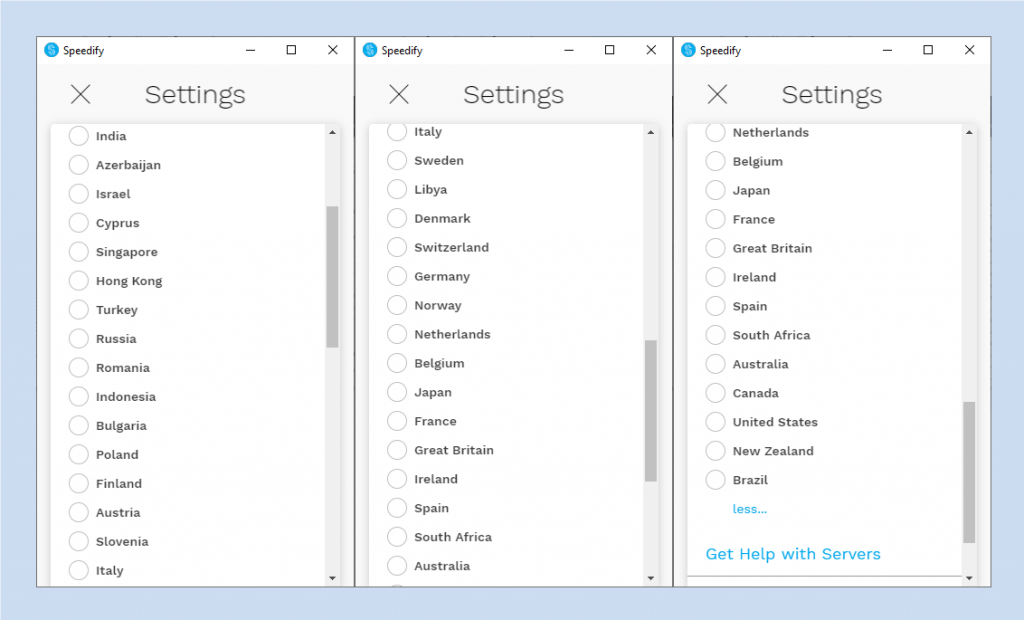
They have got more than 200 servers in over 50 locations across the globe.
It is a decent number of servers which are scattered around six continents. They have also got some servers dedicated to P2P sharing.
With these many servers, one can expect not to come across high traffic servers and expect good speeds. The service generally finds the optimum server for the user, and the user can also choose the server manually.
The P2P servers are easy to connect. The service again finds the optimum P2P server for the user or the user can also decide to go hard way of finding a P2P server manually from the server list.
Majority of the servers are in North America or Europe. They have got two server locations in Africa as well which is pretty rare.
The Asians can also expect a Speedify server not very far away from their location, especially the south-east Asians.
Privacy Policy
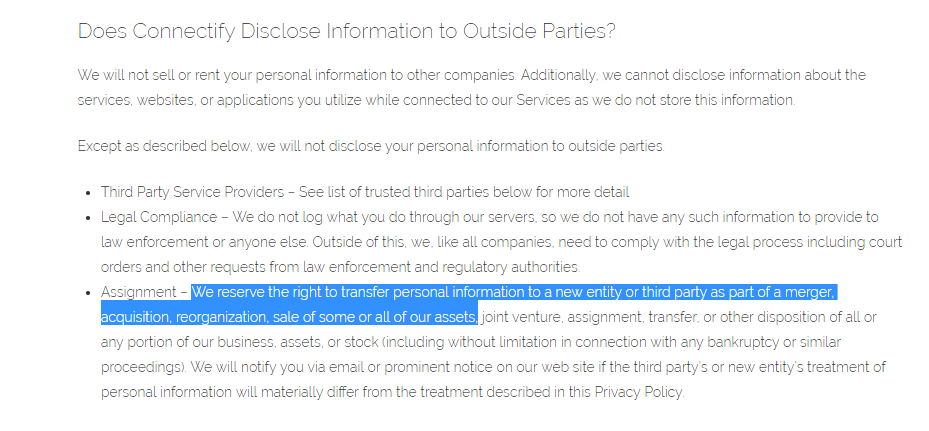
If a VPN service claims of a no-logging policy, it does not necessarily mean the same thing in all the cases. And we have got one more VPN service which claims of a no-logs policy.
We carefully went through their privacy policy, and here are the facts from it in front of you.
Browsing activity inside the VPN tunnel such as IP addresses of the websites visited, data sent or received during the session, etc. are not stored or collected by the VPN provider in any way.
However, they do store the IP addresses of the users and try to justify it by saying that it is to improve the services and troubleshoot issues if any.
There is a clause which states that the user’s data will not be sold or rented to any third party, but there is also a clause which said that they reserve the right to transfer the user’s personal information to a third party if the company is selling some or all its assets. We found this a bit weird.
The personal information is stored either on their servers or on the servers of the cloud-based data management service that they use. We don’t appreciate the fact that a third party gets to handle the user’s personal data.
We can’t call them a 100% no-logging enterprise.
There is logging of some sorts, and when that combines with the fact that they are based in a 5-Eyes country, it is natural for the users to be a bit concerned.
Connection Time Analysis
| Trial no. | Fastest server | P2P Server |
|---|---|---|
| Time to establish a connection (in seconds) | ||
| 1 | 3.83 | 4.7 |
| 2 | 3.9 | 5.01 |
| 3 | 4.14 | 5.09 |
| 4 | 4.12 | 4.26 |
| 5 | 3.83 | 4.86 |
| 6 | 3.83 | 4.32 |
| 7 | 4.08 | 4.14 |
| 8 | 3.98 | 3.86 |
| 9 | 3.94 | 4.76 |
| 10 | 3.78 | 5.1 |
| Average Time (In Seconds) | 3.943 | 4.61 |
Connecting to the network on this service is a breeze.
We did the connection time analysis for the automatic server as well as the P2P automatic server. The connection times registered in both the cases are impressive.
There was a difference of less than a second in the average time of standard and P2P servers. Given the fact that there are only a few P2P servers on the network, the results are very exciting.
One of the possible reasons for these connection times can be the less complicated encryption, but that is just a probable cause at the moment, and we don’t want to take any credit away from Speedify.
An average connection time of less than 4 seconds is a tough one to beat, and Speedify is up there at the top with the heavyweights when it comes to connection time analysis.
Speed
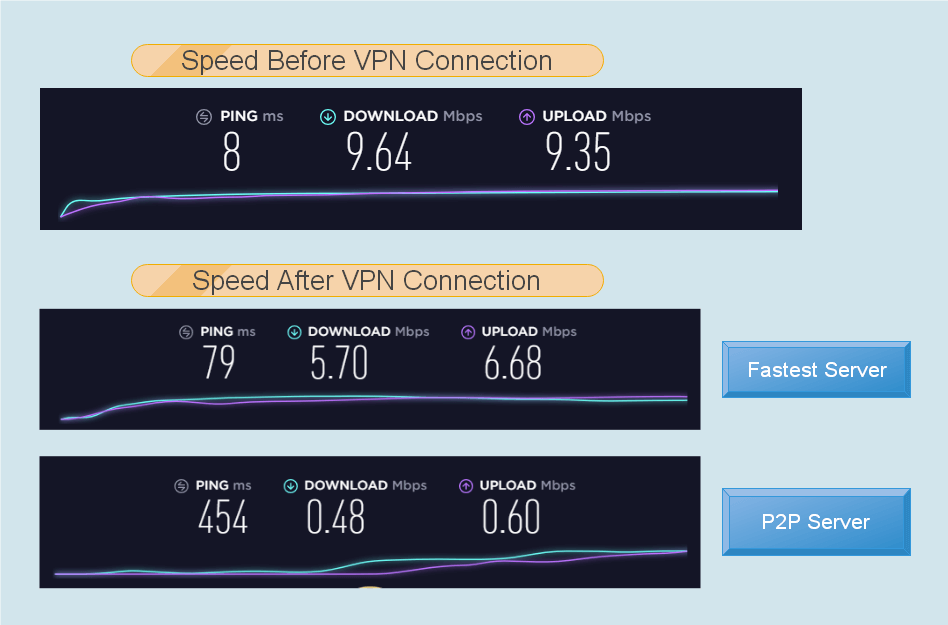
Things don’t look so bright in this department though. After the connection time analysis, Speedify got us excited, and we excepted some swift VPN action. But you don’t always get what you want.
There was a 40% decrease in the speed on the fastest server, and the P2P servers sucked the life out of the internet connection the way dementors did it in the Harry Potter universe.
The speed decreased by 95% on the P2P server, and only God knows how a download will ever get completed at such a rate.
The case was the same with the ping rate as well. There was a 10 times increase and a 56 times increase on the fastest and P2P server respectively.
We did the speed test while the device had only one internet connection as our primary focus is to gauge the output percentages.
Channel Bonding will give better speeds for sure as there will be more than internet connections involved, but the percentages are likely to remain the same.
The dedicated speed servers, which are focused on providing high speeds, yield a minimum of 1 Gbps speed.
We came across many VPN services which are already maintaining 10 Gbps servers, and when the high-speed servers are having a capacity of only 1 Gbps, then no wonders should be expected.
They have called themselves the fastest VPN service of 2019, but we don’t see that statement being justified in any way.
Security
‘Speedify protocol’ — This is the protocol used in this VPN service.
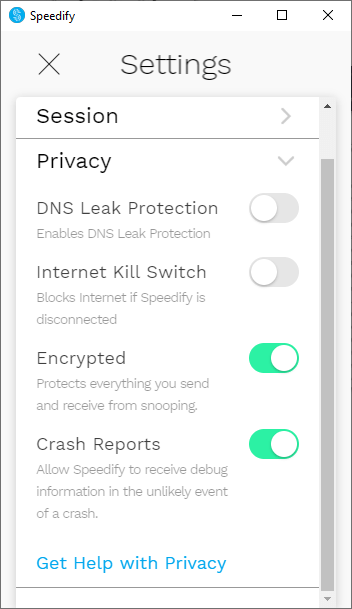
They came up with their own protocol which is a bold move, but it can also backfire in many ways.
It uses AES 128-bit encryption for all the devices which support AES, and if the device is an old one and does not support AES, then they have got ChaCha in store for such users.
Even though 128-bit encryption is safe enough, we do expect the highest grade encryption possible because it will only tighten up the security.
However, using 128-bit encryption frees up some of the computing capacity of the processor as well, and the devices are more efficient dealing with 128-bit encryption rather than 256-bit.
Since the protocol is one of its kind and there is not much information about its performance against security threats, we would like to hold our opinion on the security front of the protocol for now.
There is one chink in the armor for sure though. There is no IPv6 leak protection.
This is strange for us because we were considering this a technologically advanced product, and missing IPv6 leak protection can cost them a few probable customers.
Other features such as DNS leak protection and Internet kill switch are available, but there are some issues with the reliability of DNS leak protection too.
Internet kill switch stops the internet traffic if the VPN connection drops so that there is no risk of data leak on the internet.
User Interface and Experience
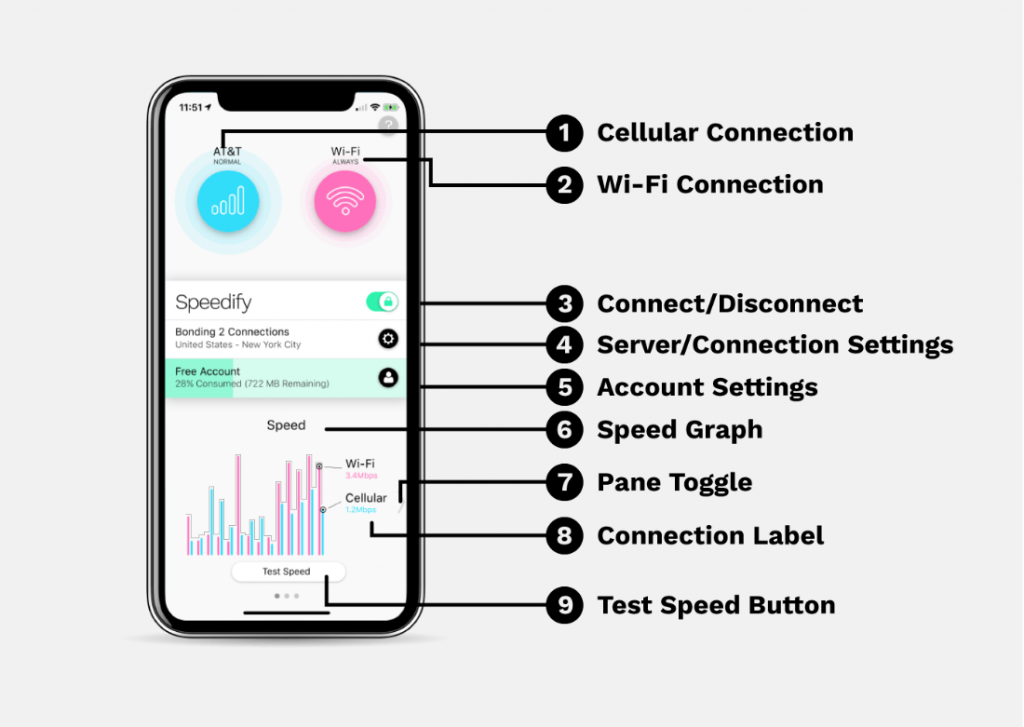
The user interface is essentially the same on both PC and mobile devices across all the platforms.
The UI is easy to use, informative and looks good as well. On the top, it shows the internet connections to which the device is connected and an ‘add connection’ option along with it.
There is a toggle switch to connect to the VPN, along with the information about server location and data consumed.
On the lower half of the UI, the user can swipe between infographics showing connection speed, volume, and quality. We found this panel very interesting and useful.
The user can monitor how the multiple connections are being used together in real time to give better outputs.
The settings menu has been divided into three parts namely servers, session, and privacy.
In the ‘Servers’ tab, the user gets to choose if he/she wants to connect to the fastest server or a P2P server or select a server manually.
There is no option for dedicated streaming servers on the standard account. The professional can however purchase dedicated streaming servers for their needs.
There is no option for dedicated streaming servers, and we think the reason for that is the fact that they don’t have much to offer when it comes to streaming.
Netflix can’t be accessed through Speedify servers.
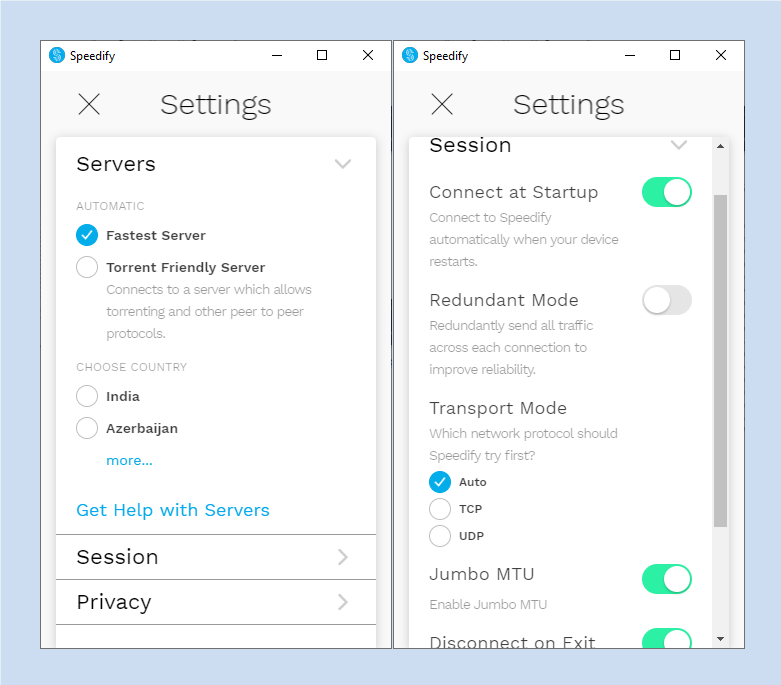
In the ‘Session’ tab, there are toggle switches for redundant mode, transfer protocol, and other usual features.
In the end is the ‘Privacy’ tab which gives switches for DNS leak protection, Internet kill, and encryption.
The UI is helpful and user-friendly. We have no complains whatsoever with the UI as they were able to showcase all the features of the client on the UI.
Platforms and Devices

The service is available only for Windows, MacOS, Android, and iOS.
Yes, that is it.
We were also surprised to see such limited platform support. There is no support for gaming platforms such as Xbox and PS, no Kodi, no routers and all the other platforms are missing as well.
However, they propose a solution to this problem with a different software of theirs called Connectify Hotspot. The user can download the software and have a VPN cover for the rest of his/her devices as well.
It is maybe the case because they need more time to make their protocol ready for all the platforms, but that is just speculation at the moment.
Speedify needs to increase the platform support to keep its competitors at bay. Moreover, a modern-day VPN user is not limited to mobile and desktops, there are so many devices and platforms which connect to the web, and the user needs VPN for all these devices.
Customer Support
There is no live chat available. The user can generate query tickets which will be answered in due time.
They work from 10:00 am to 5:00 pm on the US eastern time scale. So, if the user submits a query in this period, he/she can expect a swift response.
Rest of the night owls and non-American residents need to wait for them to open their offices.
However, the responses are satisfactory and informative. We got concise answers to all our questions and had no complaints whatsoever from the support team other than the fact that we had to wait for more than 12 hours at times to get a response.
The ‘Support’ page on the website is more like a tethering guide.
In order to use the channel bonding technology effectively, the user needs to be connected to as many internet connections as possible.
Speedify takes care of that in its support page by providing guides for almost all the possible internet connections.
We do appreciate the effort, but it would have been better if all the connection guides were arranged in a separate section.
A lot of relevant topics were left untouched even though the support page is filled with so many bullets.
They should discuss the general topics related to the VPN, such as security, a bit more to throw some more light on the product from the user’s perspective.
Conclusion
It is promising as well as a refreshing product.
It not only includes a useful new feature but a new exclusive protocol as well. Speedify is one of those products which stirs up the things and makes everyone competitor make more efforts. These kinds of things are always beneficial for us, the users.
Channel bonding is what makes this service stand out from the rest and that too in a good way.
However, there are still a lot of things that Speedify needs to work on to become a serious contender for the best VPN service out there.
They need to find ways to increase the speed on the network, make the service available for more platforms especially the routers and make their logging policy more transparent.
Speedify still has to cover quite a distance before it becomes one of the prominent VPN services.
